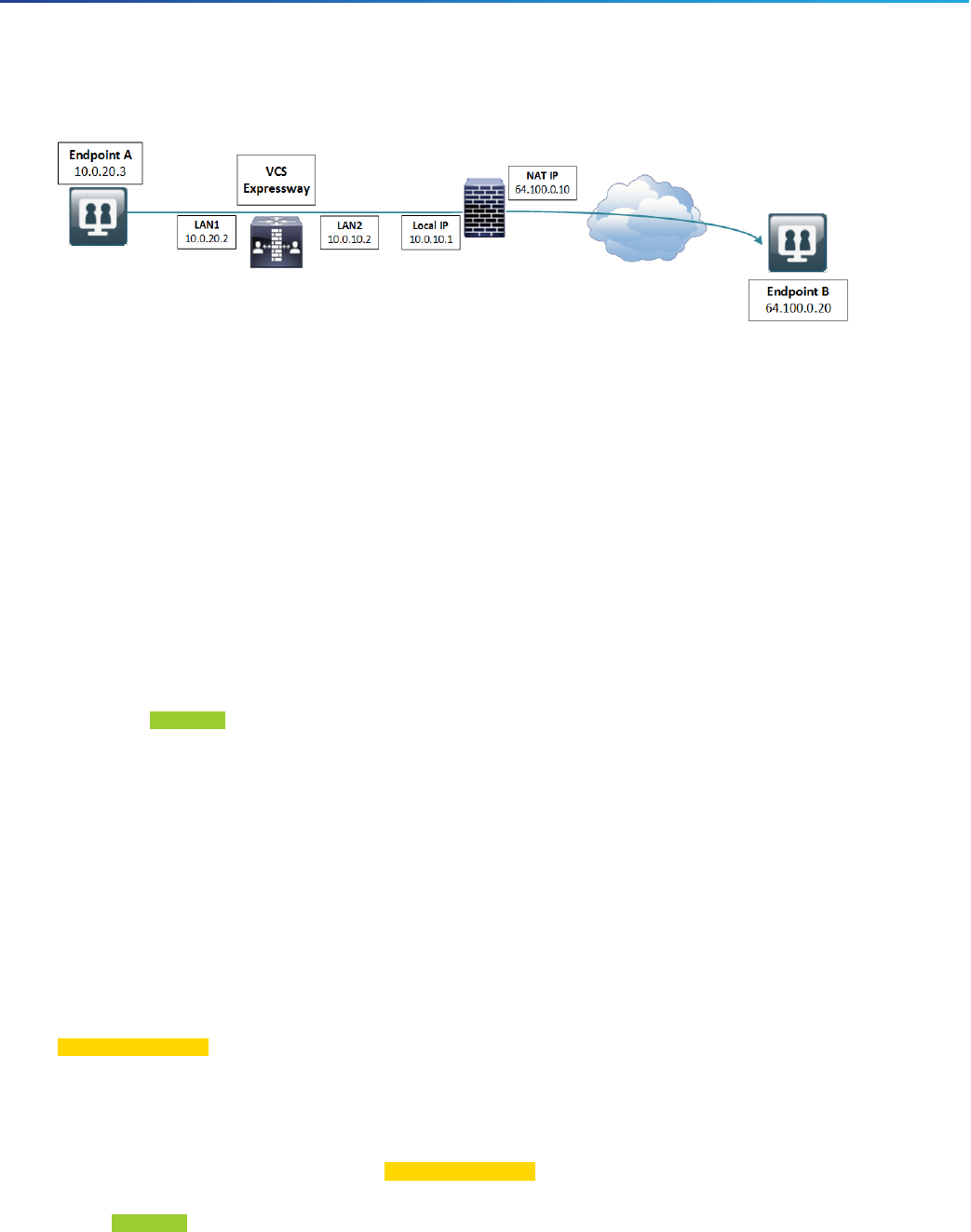Manual
Table Of Contents
- Preface
- Introduction
- Process Summary
- Prerequisites
- Run the Service Setup Wizard
- VCS System Configuration
- Routing Configuration
- Pre-search Transforms
- Search Rules
- Task 8: Configuring Transforms
- Task 9: Configuring Local Zone Search Rules
- Task 10: Configuring the Traversal Zone
- Neighboring Between VCS Clusters
- Task 11: Configuring Traversal Zone Search Rules
- Task 12: Configuring the DNS Zone
- Task 13: Configuring DNS Zone Search Rules
- Task 14: Configuring External (Unknown) IP Address Routing
- Endpoint Registration
- System Checks
- Maintenance Routine
- Optional Configuration Tasks
- Appendix 1: Configuration Details
- Appendix 2: DNS Records
- Appendix 3: Firewall and NAT Settings
- Appendix 4: Advanced Network Deployments
- Obtaining Documentation and Submitting a Service Request
- Cisco Legal Information
- Cisco Trademark

Figure 12 Example Deployment with Static NATon Firewall
■ NAT router with local IP address 10.0.10.1 and NAT IP address 64.100.0.10, statically NATed to 10.0.10.2
■ VCS Expressway LAN1 (internally-facing interface) with IP address 10.0.20.2
■ VCS Expressway LAN2 (externally-facing interface) with IP address 10.0.10.2 (and with static NAT disabled)
■ VCS Expressway default gateway set to 10.0.10.1 (inside address of NAT firewall, reachable via LAN2)
■ Endpoint A with IP address 10.0.20.3, registered to VCS Expressway
■ Endpoint B with IP address 64.100.0.20, located on the Internet, not registered to the VCS Expressway
Assume that endpoint A places a SIP call towards endpoint B. The call will arrive at the VCS Expressway, which will
proxy the SIP INVITE towards endpoint B. The VCS Expressway to Endpoint B will then be a traversal call, which
means that the VCS Expressway will take both signaling and media, and the packet carrying the SIP INVITE message
will have the following contents as it arrives at the NAT router (the actual INVITE contents have been simplified for
ease of reading):
SIP INVITE Arriving at NAT Router
Packet header:
Source IP: 10.0.10.2
Destination IP: 64.100.0.20
SIP payload:
INVITE sip: 64.100.0.20 SIP/2.0
Via: SIP/2.0/TLS 10.0.10.2:5061
Via: SIP/2.0/TLS 10.0.20.3:55938
Call-ID: 20ec9fd084eb3dd2@127.0.0.1
CSeq: 100 INVITE
Contact: <sip:EndpointA@10.0.20.3:55938;transport=tls>
From: "Endpoint A" <sip:EndpointA@cisco.com>;tag=9a42af
To: <sip: 64.100.0.20>
Max-Forwards: 70
Content-Type: application/sdp
Content-Length: 2825
v=0
o=tandberg 1 2 IN IP4 10.0.10.2
s=-
c=IN IP4 10.0.10.2
b=AS:2048
…
…
…
In the example above, the SDP (session description protocol) within the SIP payload contains a reference to the VCS
Expressway IP address, marked in yellow: c=IN IP4 10.0.10.2.
Upon receiving the SIP INVITE packet, the NAT router will rewrite the layer 3 source IP address header (marked in
green: 10.0.10.2) and replace 10.0.10.2 (VCS Expressway LAN2 IP address) with its own public NAT address
66
Cisco VCS Expressway and VCS Control - Basic Configuration Deployment Guide
Appendix 4: Advanced Network Deployments










